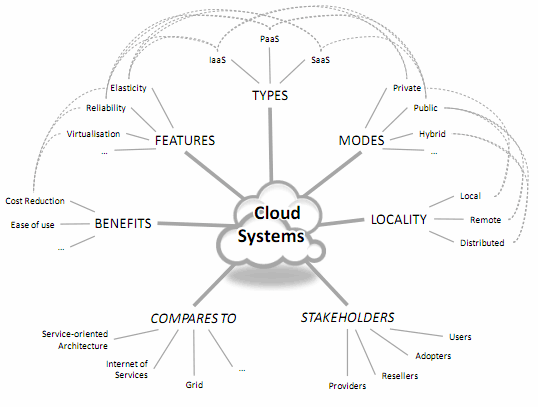Cloud computing is a general term for anything that involves delivering hosted services over the Internet. These services are broadly divided into three categories: Infrastructure-as-a-Service (IaaS), Platform-as-a-Service (PaaS) and Software-as-a-Service (SaaS). The name cloud computing was inspired by the cloud symbol that's often used to represent the Internet inflowcharts and diagrams.Advanced clouds typically include other computing resources such as storage area networks (SANs), network equipment, firewall and other security devices. Cloud computing also describes applications that are extended to be accessible through the Internet. These cloud applications use large data centers and powerful servers that host Web applications and Web services.

A cloud service has three distinct characteristics that differentiate it from traditional hosting. It is sold on demand, typically by the minute or the hour; it is elastic -- a user can have as much or as little of a service as they want at any given time; and the service is fully managed by the provider (the consumer needs nothing but a personal computer and Internet access). Significant innovations in virtualization and distributed computing, as well as improved access to high-speed Internet and a weak economy, have accelerated interest in cloud computing.

Cloud computing: the rise to prominence Cloud computing offers a new better and economical way of delivering services and all the stakeholders will have to embrace the dramatic changes to exploit opportunities to avoid becoming irrelevant.
Cloud computing introduces significant concerns about privacy, security, data integrity, intellectual property manage¬ment, audit trails, and other issues. Because higher education is subject not only to institutional policies but also to a broad range of state and federal regulations, these issues are complex and be¬come even more difficult in the context of inter-institutional cloud initiatives. Because of the control that consumers of cloud ser¬vices cede to providers, successful initiatives rely on a high degree of trust between a college or university and a supplier, including confidence in the provider's long-term viability.
The emergence of cloud computing as a viable option for a growing number of IT services speaks to a level of Internet penetration and infrastructure maturity that did not exist just a few years ago. Analysts expect cloud computing to see main¬stream adoption in 2-5 years, and some higher education IT lead¬ers believe that cloud computing programs on campus will increase considerably in the coming years. To the extent that these efforts are successful, confidence in the model and trust in provid¬ers will grow, and institutions will be more amenable to transfer¬ring a larger number of services to the cloud. Conversely, a breach of trust by a cloud provider would likely leave institutions uneasy about cloud services.





















Google launches Chrome OS, says Windows is 'torturing users'

Red Hat claims virtualization improvements in RHEL 6.1 released

How to transform your data center for cloud computing: an expert guide